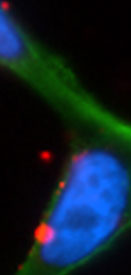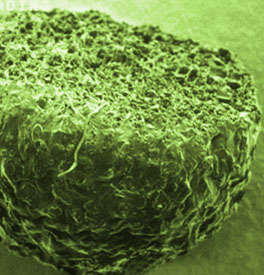Developing nanotechnology-based cancer therapeutics
Using nanoscale particles loaded with chemotherapeutic agents – and covered with homing molecules that allow them to selectively bind to cancer cells – our investigators are building a new class of "smart bombs" for cancer. These functionalized nanoparticles hold the promise of both reducing toxicity and improving efficacy of a wide range of existing anti-cancer agents. Nanotechnology is also being applied to RNA interference (RNAi), which can be used to silence genes in many biological systems. RNAi could be used to inhibit the function of virtually any cancer-causing gene.
be used to inhibit the function of virtually any cancer-causing gene.



Research Summary The goal of this area is to develop cancer therapeutics for the 21st century based on nanotechnology. Current therapeutic agents for cancer are small molecule drugs that either damage DNA or target intracellular proteins and antibodies that bind to and block the activity of extracellular proteins. Some of these agents work effectively for certain cancer types; however, all too often, cancer therapies are woefully inadequate.
The emerging generation of molecularly targeted anti-cancer agents, contributed to significantly by MIT investigators, has improved treatment in select cancer types to date. Despite this progress, there is a pressing need to develop even more powerful approaches to cancer therapy, indeed to establish entirely new paradigms for cancer treatment. For example, using nanoscale particles loaded with conventional chemotherapeutic agents and covered with homing molecules that allow them to selectively bind to and enter cancer cells, our investigators have built a new class of "smart bombs" for cancer. Preliminary tests in pre-clinical models have given very encouraging results to date.
These functionalized nanoparticles hold the promise of both reducing toxicity and improving efficacy of a wide range of existing anti-cancer agents. Clinical trials in humans are already being contemplated with this first class of nanoscale therapies. Future work in this program will focus on the generation of nanoparticles that can literally seek out cancer cells wherever they might be in the body and specifically deliver their payloads at high doses, thus eliminating the cancer cells without causing unwanted tissue damage.
Nanotechnology is also being applied to develop the promising new field of RNA interference (RNAi) for therapeutic purposes. Discovered only in the last decade, RNAi is a powerful tool that can be used to silence any gene of interest in many biological systems. To date, RNAi has been used largely for research applications, involving cells grown in the laboratory or model organisms. Multi-disciplinary teams of biologists and engineers at MIT are working together to move this technology forward so that it can be used one day to inhibit the function of cancer genes for cancer therapy.
Our goal is to develop improved delivery methods such that RNAi molecules can be given safely and effectively in cancer patients. Again, targeting the RNAi molecules selectively to cancer cells will likely be required to achieve the desired therapeutic index. Similar approaches are being developed for delivering therapeutic DNA molecules to cancer cells in vivo, including to replace the function of mutated tumor suppressor genes.





